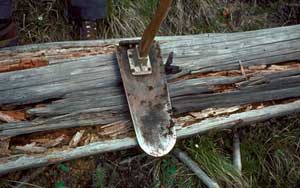Description
Hoedads, also called planting hoes or mattocks, are widely used for outplanting reforestation and restoration stock. They were developed specifically for planting bareroot conifer seedlings but have been adapted for use in planting container stock. They come in a variety of sizes and shapes and are very versatile, used for both planting and scalping.
The hoedad has a long wood or fiberglass handle that attaches to a blade at the base. The brackets that hold the handle to the blade are brass for heavy-duty use or tin alloy for lighter applications. Brackets can be found in two blade angle configurations: 100° angle for applications on gently sloped or flat areas and 90° angle for steep-ground planting. Blades require regular sharpening with a metal file or electric grinding wheel. It is good to keep spare blades, handles, and nuts and bolts with matching socket or box wrenches at the revegetation site.
Application
Hoedads are useful for level or steep sites with heavy or rootbound soils but less useful on rocky and compacted sites. On sites with plant competition, the back and side of the hoedad blade can be used for scalping. For planting, the hoedad is swung much like a pick. With each swing, the planter lifts up and back with the butt of the handle to open the planting hole. Once the hole is opened, the tip of the hoedad is used to gently loosen soil on the sides of the planting hole to prevent compaction. The plant is then inserted at the proper depth and held in place while the hoedad blade is used to backfill the soil and soil is tamped down around the plant. While planting rates vary with container size, planter skill, and terrain, beginners can plant 20 seedlings or plugs per hour and experienced planters can plant 100 or more plants per hour. Rates can be even better (≤240 plants/hr) for wetland restoration if soil conditions are favorable and small planting stock is used.
References / Additional Information
Adams, M.B. 2017. The Forestry Reclamation Approach: Guide to successful reforestation of mined lands. Gen. Tech. Rep. NRS-169. Newtown Square, PA: U.S. Department of Agriculture, Forest Service, Northern Research Station. 128 p.
Haase, D.L.; Landis, T.D.; Dumroese, R.K. 2014. Outplanting [Chapter 17]. In: Wilkinson, K.M.; Landis, T.D.; Haase, D.L.; Daley, B.F.; Dumroese, R. K., eds. Tropical nursery manual: A guide to starting and operating a nursery for native and traditional plants. Agriculture Handbook 732. Washington, DC: U.S. Department of Agriculture, Forest Service: 313-337.
Shaw, N.L.; Halford A; McAdoo, J.K. 2015. Establishing big sagebrush and other shrubs from planting stock. Great Basin Factsheet Series No. 8. Sage Grouse Initiative. 6 p.
Superior Forestry. 2011. Planting pine seedlings with hoedad. Superior Forestry YouTube Channel: https://www.youtube.com/user/SuperiorForestry


